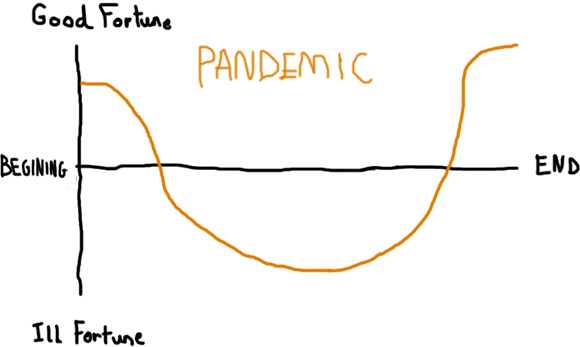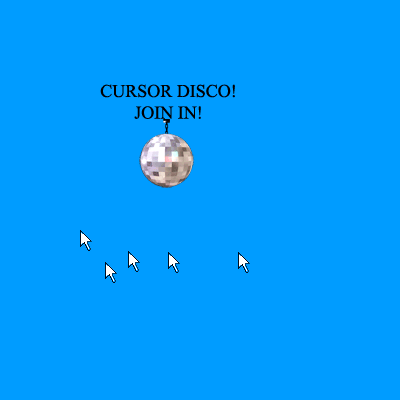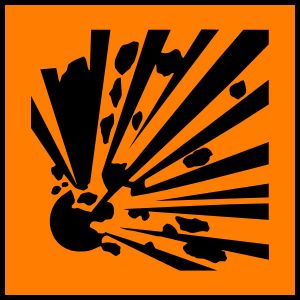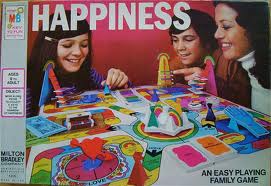In the words of the rightly forgotten post-grunge angst rockers ‘Staind’: it’s been a while.
What can I say? We’ve had stuff on. Unfortunately only some of it has been game design related. Having won the inaugural UK Games EXPO board game redesign competition in 2014 we are trying to get the winning game published with little success. Alongside this we had a bit of interest in a dice game we started designing years ago, all of which fell through too. It got a bit dispiriting, we got a bit busy with other stuff. We’ve mentioned before that Sam and I use Google Docs, Chat and Sites almost exclusively for our collaborations (board game design, fantasy fiction, collaborative fiction, surreal soap opera scripts- the usual) and we have thousands of words in there, much will never see the light of day. We decided this week that some of it should: we put up print and play rules for Dicelantis a push-your-luck take-that dice-chucker designed to be played in a pub.
Let me tell you what happened.
Design Diary: Dicelantis
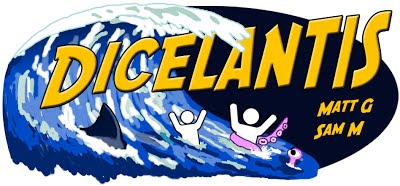
It all started on my 36th birthday with this post by Travis from Indies Boards and Cards. The request was for a push your luck dice game using D6s and at most a score pad. It seems like a fair request but it’s tougher than it first appears, something I noted and Sam promptly ripped on me for because, make no mistake:

I love working with Sam. And anyway I only look a bit like that cat.
We decided to team up and send in a submission. The first concept was Maelstrom Dice, for which I whipped up these awesome dice face sticker templates:
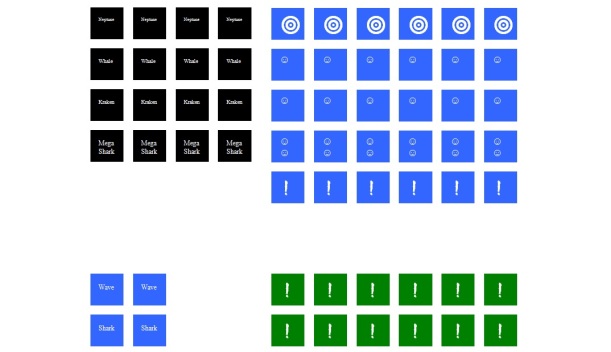
Lesson #1: Never, ever, let Matt do graphic design.
We got a GDoc set up for the rules and Sam promptly turned it into a refuse bin of ideas, rules, “Protips” (patronising strategy hints aimed at the criminally feckless- I think he’s worked them out of his system now) and a mini-review of another game. With judicious use of blank space, I sorted out a first set of rules and printed off a copy to take to The Jugged Hare in Victoria, home of the London PlayTest sessions organised ruthlessly with clipboards, timings and military precision by the wonderful Rob Harris.
Aside: PlayTest is singularly amazing. Go. Find one: attend.
Notes following playtesting on 01/07/12
- too many sharks. Rolls of 3 sharks 3 survivors and a two waves led to no rerolls. Rolling 3 or 4 sharks is dispiriting. Mermaid seen as essential and white dice w/wave much liked as the game proceeds at a good rate.
- so hard to claim a survivor that dice starting overflowing the cup.
- too many icons. Point was made that King of Tokyo has 4 different icons to learn, and this has 10.
- neptune does not do enough as the effect happens after pairing
- key point: the game feels too prescriptive whilst it’s fair and the mechanics work there are too few decisions for the players to make. The game pairs up what you roll leaving you with very little if anything to reroll and the decisions were often obvious.
So. Some stuff to work on there, then.
Sharks were the bane of our lives for years with this game. It started out such that you rolled ‘n’ blue dice (it changed) and if you rolled 3 sharks your turn ended. This was, singularly, the worst thing about the game for about 2 years: it led to so much raw misery in playtesting that it had to change…but to what? The concept of a shark attack was something we wanted to keep in the game. Travis was looking for a push-your-luck game; we became obsessed that sharks were to be where your luck ran out. In hindsight it was quite clear we had no idea what we were doing.
Losing your turn in a game is horrible. Such games effectively steal your time, something that I wrote about a few years back, not coincidentally. Coupled to this are the broader mechanisms of dice chuckers, particularly working around players that will throw dice one at a time if you allow them to. This is where the Yachtzee/King of Tokyo mechanism of “1 roll, 2 re-rolls” shines: it stops that, reducing down time dramatically. Give a player infinite re-rolls and they can roll dice one at a time until they get 2 sharks and then stop. Which is hellishly dull. But then 1 roll, 2 re-rolls designs are not push-your-luck, they are maximisation games or ‘roll and see’ games. I went away and read a book.
We submitted the original 1 roll, 2 re-rolls version to Travis, who came back to us with some good feedback. He liked the black dice being used as a take that mechanism (everyone we have ever shown the game to has liked that; it’s the hook that grabs players when we are explaining it and has been the driving force behind our continued interest in the design). He also liked the diminishing dice as a clock idea…and that was about it.
Dicelantis was a set collection game at that point: you had to roll pairs of icons to claim scoring dice from the island. Claiming dice from the island was something we wanted to keep too: when demonstrating the game, putting a 3×3 square of dice on the table and saying: “This is the island of Dicelantis” is a) really visual and b) makes things obvious that it will be reducing in size before you’ve said anything else.
Playtesting continued at PlayTest and with friends and families, local games groups and anyone we could rope in. The feedback kept coming in that rolling three sharks was miserable. One game I sat in had someone roll three sharks on their first roll of the game at which point I lost them: they stopped caring. The final straw came when a tester took no turns in a game, and so that mechanism had to die. I took a wicked-looking rusty knife to the rules and came up with version 3 that used 6 dice as the engine with two different icons: waves and ‘things in the water’.
- Waves: effectively blank faces
- Things: Either a treachery dice, a raft of survivors, or sharks.
Expanding on that, players bought ‘things’ depending on the number of icons they rolled:
- thing: Nothing
- things: 1 score dice
- things: 1 treachery dice
- things: 2 score dice
- things: Sharks! End your turn.
- things: Either 2 treachery dice or 3 score dice
-this has remained in this form ever since. The principle that a score dice can be ‘bought’ for 2 icons and a treachery dice can be bought for 3 icons seemed to stick with testers. It’s reasonable logic. Exactly what was on the dice you bought remained in a state of flux for years to come.
We meddled with the rules and re-submitted to Travis, but he didn’t like the table of results (it wasn’t what he had in mind for the game he wanted), he also thought it wasn’t “push-you-luck” enough. In truth, it wasn’t, although there are elements of it there with the teaser to ‘shoot the moon’ and go for 6 things. We mothballed the game, both of us burned out on it.
Two years later, Travis found what he was looking for and Indie Boards and Cards launched the Kickstarter for Dragon Slayer by David Mortimer a fine gentleman who also frequented the dice rich upper reaches of The Jugged Hare.
Which left us with a not-push-your-luck dice game and a whole lot of things learned about designing dice games. We also had a decent concept with a few good mechanisms badly welded to a half-baked dice game. However, we now had a bit of freedom in that we didn’t need to kid ourselves that Dicelantis was or needed to be a pure push-your-luck game.
Summer 2013: UK GAMES EXPO.
Sam had interviewed Larry Roznai of Mayfair Games the previous year. He hatched a plan to get us in front of him to pitch Dicelantis. He agreed. We beat ourselves back into action and looked at Dicelantis again. Fresh eyes on the game, we looked to simplify the number of icons and make the game feel more cohesive. At some stage we settled on 3/6/9 dice of three different types: 6 to throw and drive the game; 9 to score and count the game down and 3 to give uncertainty. Two icons and 2 different faces on the drive dice, 2 icons and 4 different faces on the score dice (duplicated scoring icons on some faces), and 4 different icons and faces on the treachery dice. Eight icons for players to remember, which isn’t bad.
Sam beat the rules off the GDoc and tarted them up to fit into a really lovely sample of a metal cannister he blagged from somewhere. We put a sticker on the front and gave Larry a copy after a chat in a bar. Larry gave it to Alex Yeager who came back with the sort of pithy focussed feedback that we needed:
It certainly lives up to the short play time promise, but games don’t seem to build to any kind of mid game climax, especially at the high end of the player count. Dice disappear into player’s pools, and single-round games have become semi-commonplace (no one “pushes their luck,” as there’s no guarantee that there will be a second turn!).
Blam! Gutshot. Nice game, shame it isn’t one.
We could up the scoring dice to a 4×4 block adding 7 dice to the game, that would give it some longevity. Alternatively we need to get dice out of players’ pools and back into the middle. Right. We’ll get onto that then. We didn’t- we abandoned it in a collective strop.
Tentacles are funny things. I was at an aquarium in New Zealand and watched an octopus grab a crab and pull it back into the water. Seems reasonable that Atlantean krakens would do the same….
I started re-working the treachery dice faces casually and messing with what they could do and what they cost the player rolling them. Working from the start point that each player scores about 2.2 points per turn, then each of the treachery faces should be roughly equalised around that cost and all be equally bad.
Megashark ends your turn immediately. Always has.
Kraken moves survivors from place to place. It has, in the past, variously moved them between players; from players in the lead as a balancing mechanism and I think just about all points in between.
Whirlpool also moves dice around. It removed dice from the game at one point.
Neptune is worth 2 points at the end of the game. When you claim a treachery dice it comes to you as this face. If you don’t use it before the end of the game you score two points.
With the steer from Alex that we needed a mid-game, the kraken and whirlpool were the faces to consider. The whirlpool dragging dice back to the middle seemed a good start, dragging back the dice with the highest number of scoring icons would also act as a balancer too. The breakthrough with the kraken was the thought that it should eat icons rather than dice. The scoring dice have faces with 1/2/3 icons- having the kraken ratchet the faces down to 1 and then 0 (back to the middle) was fun. Playtesters liked it and found it straightforward to deal with, so we went with that. From this point we kept playing Dicelantis and kept it pottering on developmentally as a pretty laid back pace.
Summer 2014: UK GAMES EXPO.
The other thing Sam and I did at EXPO 2013 was sign up for the boardgame redesign competition. We won. It was a cold and calculated attack on winning the competition, which I think we took too seriously in retrospect. We poured 100s of hours work into A World Destroyed. In the end we won a friend. I’ve never won a friend in a competition before, I can only look forward to doing so again. We got some mentoring from Alan via Skype, who moves in different designer circles than we do (actual ones with good designers in them). The problem of our investment capital became clear- we didn’t have any.
Alan: “You can get to the Nuremberg show for about £500”
Me : “I could buy a new dining room table for £500…”
A World Destroyed is another game for another time. The OTHER thing that happened at EXPO 2014 was Sam and I shanghaiing Zev from ZMan games into a demo of Dicelantis. Zev is the nicest guy to demo to, it was real pleasure. After a slightly iffy start where Sam was going to run the demo (he hadn’t read the rules in 6 months), we were flying.
Lesson #2: Don’t let Sam run the first demo of anything.
Zev was enthused and took the demo copy back with him to Filosofia and asked that we didn’t demo it again until he got back to us. We were over the moon about this. It was a great EXPO for us from a design point of view. The realities of game game publishing soon pummelled us back to earth.
Some good feedback from Zev at the show was that treachery dice should be pain. We don’t want anyone ‘hoping to roll a Neptune’. Pain. They also need to add uncertainty to the game, in as much as vary the game end point by putting dice back in the middle. At this point in time black dice were ‘claimed’ showing a face that was originally a crystal skull and later become the face of Neptune. Unfortunately, that face could be rolled when the treachery dice was put into an opponent’s cup. Now, this was my mechanism that dated back to when the game was a set collector. Over 3 years later it was still there…for no reason at all now. That went. Down to 7 icons and a 2 Whirlpool/2 Megashark/2 Kraken face distribution on the treachery dice. That was easy.
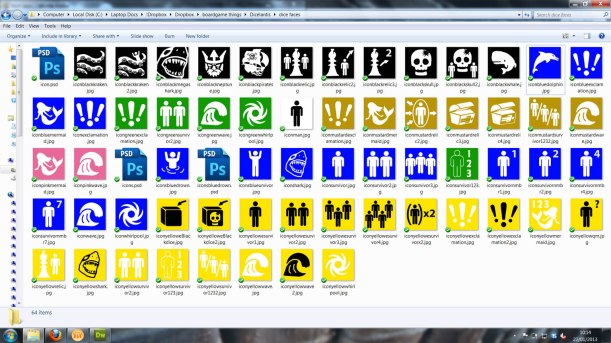
Neptune wasn’t the only icon to fall by the wayside. Don’t ask me what the whale did- I honestly can’t remember. I do miss the pink mermaid dice though.
The scoring dice also needed tweaking, we thought. Rolling a 1 or a 3 was a bit too swingy and we wanted a roughly even score to encourage to inflict 2.2 points of damage rather than settle for 2 points themselves so we moved to a 1/2/2/2/3/treachery scoring dice which evened the points scores out and made the games closer to the wire in the end game.
Despite Zev liking the game, Filosofia, it seemed, were not publishing dice games that year. Nuts. We were back and enthused though! Enthused! We sent a copy up to Alan to see what his designer group thought of it.
They thought it was terrible.
Now, this is a group of Euro buffs. Dice chuckers are not their thing and they are never going to buy a game in this genre, which made their feedback absolutely priceless. We can only thank David Brain, Sebastian Bleasdale and Brett Gilbert for their time. The biggie: there was a massive start player advantage. With no treachery dice in the game, there is no risk and with the game ending after the last score dice is claimed the player who took the most turns was the likely winner. Obviously. See what I mean about ‘good designers’?
Let’s give every player other than the start player a black dice…OK, that’s a lot of fun. We’ve just put the fun in from the start. Players don’t need to ‘work towards the fun stage’ any more. OK, that seems good: we’ll go with that.
Then what happened was…well nothing. And at 2.5K words I think this is diary enough. Nothing happened. The end. We’ve sat on the files ever since. Sam’s a father now. I’m 40 in June. Dicelantis could sit on Google Drive for a few more years or we though we could do something with it.


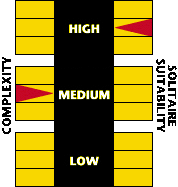



 was about something that the general gamers enjoyed too. This is why Agricola isn’t played as much as it should be. It’s better than it sounds! A lot better….
was about something that the general gamers enjoyed too. This is why Agricola isn’t played as much as it should be. It’s better than it sounds! A lot better….
